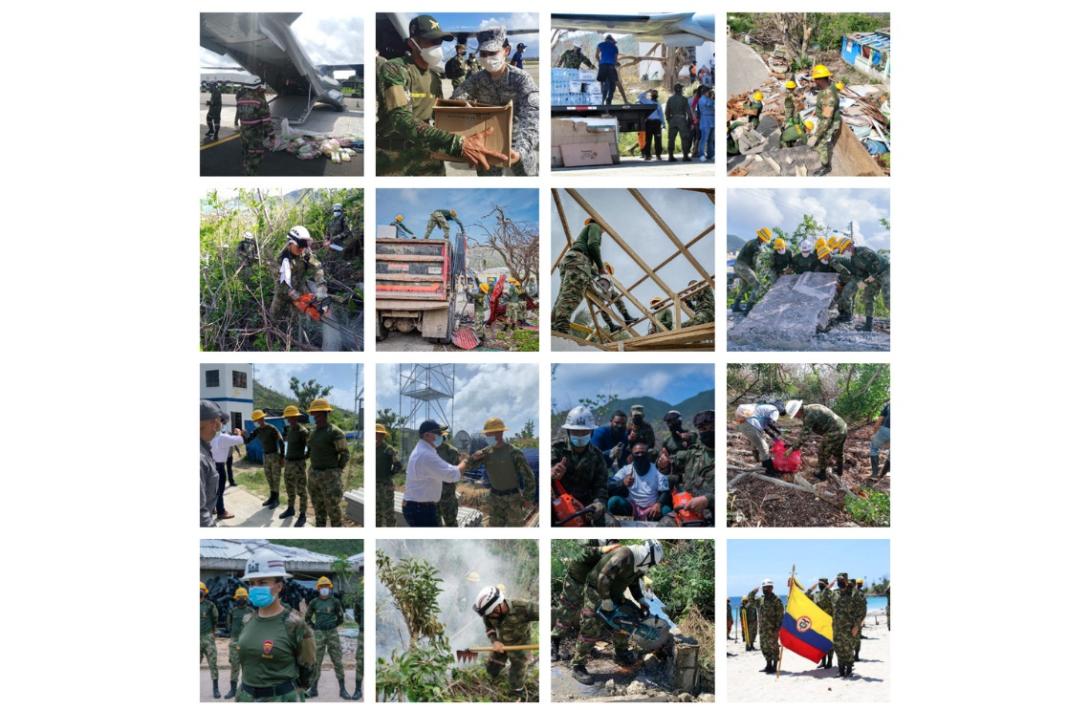11 platoons of the Disaster Prevention and Assistance Brigade on the Island.
Operation Cangrejo negro (Black Crab) for ecological recovery.
After Hurricane Iota raged through more than 90 percent of the infrastructure of Providencia and Santa Catalina, the Colombian Military began to work in a coordinated and inter-institutional manner with other governmental and departmental institutions, in order to carry out activities that would led the recovery of the infrastructure and the ecological restoration of the archipelago.
This is how the National Army, with the support of the Colombian Air Force and the National Navy, begins a humanitarian operation unprecedented in Colombian history. From different points of the country's geography, Army men and women arrived in Bogotá, who moved to the archipelago equipped with all the biosecurity equipment, structures to provide shelter to the victims, tools and rescue material to cope with the difficult conditions of the islands.
Logistics Resources
The Engineers Command deployed 11 platoons of Disaster Relief and Prevention and Military Forces transported ATVs, dump trucks and skid steers with which the first phase of work began, which consisted of the removal and collection of debris and all kinds of elements that were left by the hurricane's transit through the islands. Troops also transported and distributed humanitarian aid such as food baskets and drinking water.
Support in numbers
Thanks to the Unified operation of the State, with maritime, air and land resources; the National Army has supported the removal of 16,581 tons of debris, as well as 275 demolitions for construction of houses, 43 excavation of footings for new homes, and the download of 2,079 tons of construction material and the transport of 1320 tons of building material, and also 38 cleaning activities of material of construction for distribution of new homes and 35 temporary repair of ceilings in homes, among other activities.
Ecological restoration
The work team began with the technical recognition of the ecosystems, the state of food production in the municipal farm and in the productive yards, as well as the properties available for the construction of forest nurseries and the finding of water sources.
Then, debris was removed, fallen trees were cleaned, drainage channels were cleaned, in order to start the construction of the first forest nursery that has a production capacity of 5,000 seedlings/semester whose destination is the production of plant material for the ecological restoration of the Dry Forest, which has trees such as ceiba, coconut, ficus, wild grape and beach grape, among others. This nursery served as a learning space, where three training activities on plant propagation were conducted, for the benefit of the community.
Through the consolidation of Operation Cangrejo Negro, the National Army supported the monitoring of flora, visiting with the group of scientists 47 sectors of vegetation, taking samples in areas, identifying, quantifying and measuring different types of vegetation, defining native animals, invasive animals and their population status.
In partnership with the Humboldt Institute, a training activity on ecological restoration was carried out for personnel who are part of the Payment for Environmental Services Program of the Ministry of Environment and Sustainable Development (MADS). In conjunction with the community of the program, activities have in the same way been carried out such as the opening of drainage channels, the collection of debris, solid waste in beaches and mangroves.
With the constant and committed work of military engineers about 5,800 inhabitants of the Islands of Providencia and Santa Catalina have benefited. All this humanitarian aid continues under the leadership of the military engineers of the National Army, with the mission of working together for the Archipelago.
Source: press-National Army





